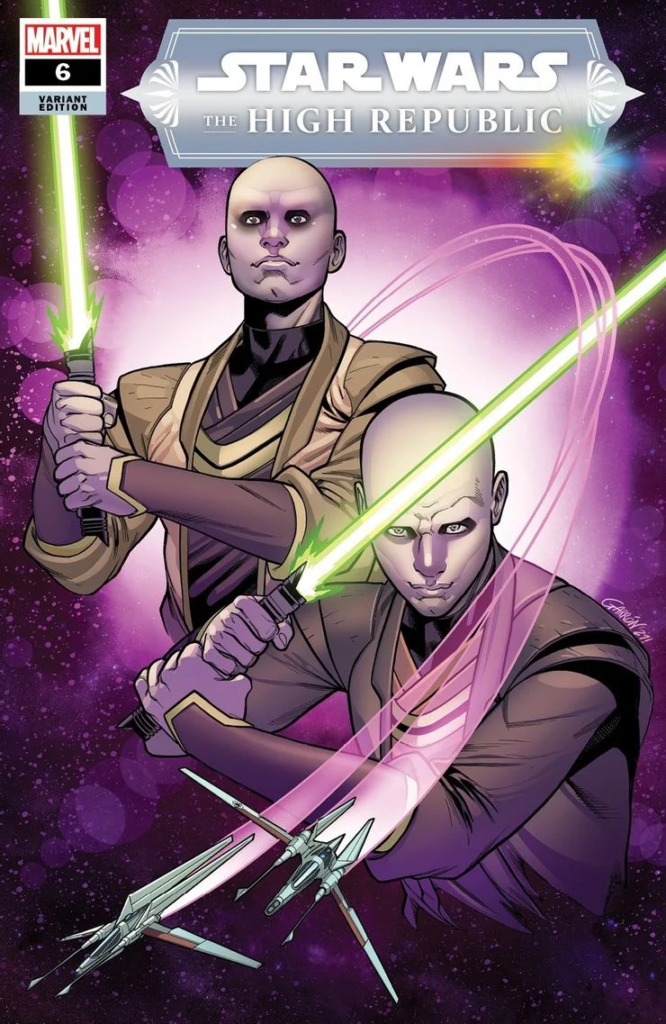
Comics Corner – Trans Star Wars fans deserve better than Terec and Ceret
Last week, the official Star Wars account on Instagram revealed the cover to the upcoming Star Wars: The High Republic #6 comic from Marvel, spotlighting Jedi twins Terec and Ceret and confirming that they were “trans non-binary Jedi”, the franchise’s first such characters.
The cover, with art by Javier Garrón, shows the twin Jedi against a galactic backdrop, proudly wielding their lightsabers, while the series’ logo gets a prismatic rainbow effect added. The art won’t be the main cover to the issue when it sees release in June – Pride month, in the US – but rather a variant that collector’s will need to hunt down.
The Instagram post was made on 31st March, Trans Day of Visibility, which since 2009 has served to highlight the existence, contributions, and needs of transgender, non-binary, and gender non-conforming people. The twins, who first appeared in February’s The High Republic #2, were previously referred to with they/them pronouns, but the Instagram post was the first time their specific gender identity was confirmed, in or out of story.
Normally, this would be something we’d celebrate. More representation for LGBTQ+ identities should be an unalloyed good, even – especially – in a galaxy far, far away. Except… this is Star Wars. This is the franchise that, after 11 main continuity movies, heavily hyped an onscreen gay moment in Rise of Skywalker, only for it to be a background kiss between two nameless women, that could be easily edited out for the movie’s release in more conservative, homophobic territories.
Star Wars is the franchise that, again in Rise of Skywalker, doubled-down on rejecting even the idea that Poe Dameron and Finn might be attracted to each other (an interpretation that even actors Oscar Isaac and John Boyega seemed interested in) by ham-fistedly splitting the two up, only to pair each of them with new female characters – one of whose face we barely even see. It didn’t matter, you see, so long as Poe and Finn were each with a woman.
It is also the franchise that, regrettably, caved in to what amounted to a hate campaign in the wake of The Last Jedi, one that drove actor Kelly Marie Tran off social media and saw her role as Rose Tico massively truncated in Episode IX. It is depressingly predictable that the reveal of Terec and Ceret being trans non-binary was met with a wave of abusive comments. Based on track record, it feels as though it’s only a matter of time until the twins’ identities are undone or the characters are sidelined.

There’s also the matter that Terec and Ceret are… look, they’re pretty weird, OK? Yes, Star Wars is a franchise with giant crime-lord slugs, furry spaceship pilots, and two foot tall green imps with superpowers – “weird” is part and parcel of the universe. But making the first open, overtly trans or non-binary characters grey-skinned, bald, near-featureless aliens who share a “gestalt mind” and unsettlingly finish each other’s sentences isn’t “good weird” in a cool, exciting manner – it’s bad representation.
It’s close to a retread of the old trope that sci-fi properties weren’t racist because they had blue or green characters, ignorant of the fact that fictional skin colours – usually played by white actors under layers of makeup – don’t actually increase diversity or representation. Here, it’s a case that actual trans and non-binary humans in the real world don’t get to see themselves in the Star Wars universe; instead, they get humanoid but distinctly non-human avatars with creepy beady eyes – a pair of Uncle Festers in space. The twins are ultimately othered in both appearance and behaviour.
To the credit of series writer Cavan Scott and artists Ario Anindito, Mark Morales, and Annalisa Leoni, Terec and Ceret do get fairly good standing as Jedi. The High Republic – a new sub-franchise, set centuries before The Phantom Menace, and with stories to be told across comics, novels, animation, and other media – portrays them as powerful Force users, who main protagonist Keeve Trennis, a newly qualified Jedi Knight, describes as “living legends”. They’re also prominent characters in the opening storyarc of the series, which sees a group of Jedi investigating strange happenings on the frontier world of Sedri Minor.
However, until the series actually puts some focus into Terec and Ceret’s background, exploring what it actually means for aliens from the planet Kotab to be trans non-binary, it’s little more than lip service to an underserved queer audience. Just as the lesbian kiss in Rise of Skywalker was shot and designed to be excised, so too do the twins’ gender identities seem structured to be easily explained away as some facet of a strange alien culture, if publication in a less accepting country depended on it.
It’s also worth noting that the twins aren’t the first non-binary characters in the wider Star Wars universe. In the current continuity, that honour seems to go to space pirate Eleodie Maracavanya, who used zhe/zher pronouns, and was introduced in the 2016 novel Aftermath: Life Debt. More recently, EA’s 2020 video game Star Wars: Squadrons featured non-binary pilot Keo Venzee – who was voiced by non-binary actor Bex Taylor-Klaus – while Taka Jamoreesa, an Alderaanian pilot who used they/them pronouns, appeared in the 2018 novel Last Shot.
Thanks to the push on the official Star Wars social media channels though, Terec and Ceret are immediately – although perhaps only briefly – the most prominent queer characters in the entire franchise. Sadly, so far, they’re not good enough. Their existence is a teetering baby step in the right direction, but after 44 years, LGBTQ+ Star Wars fans deserve more, and better, than non-human weirdos in a sub-franchise.













